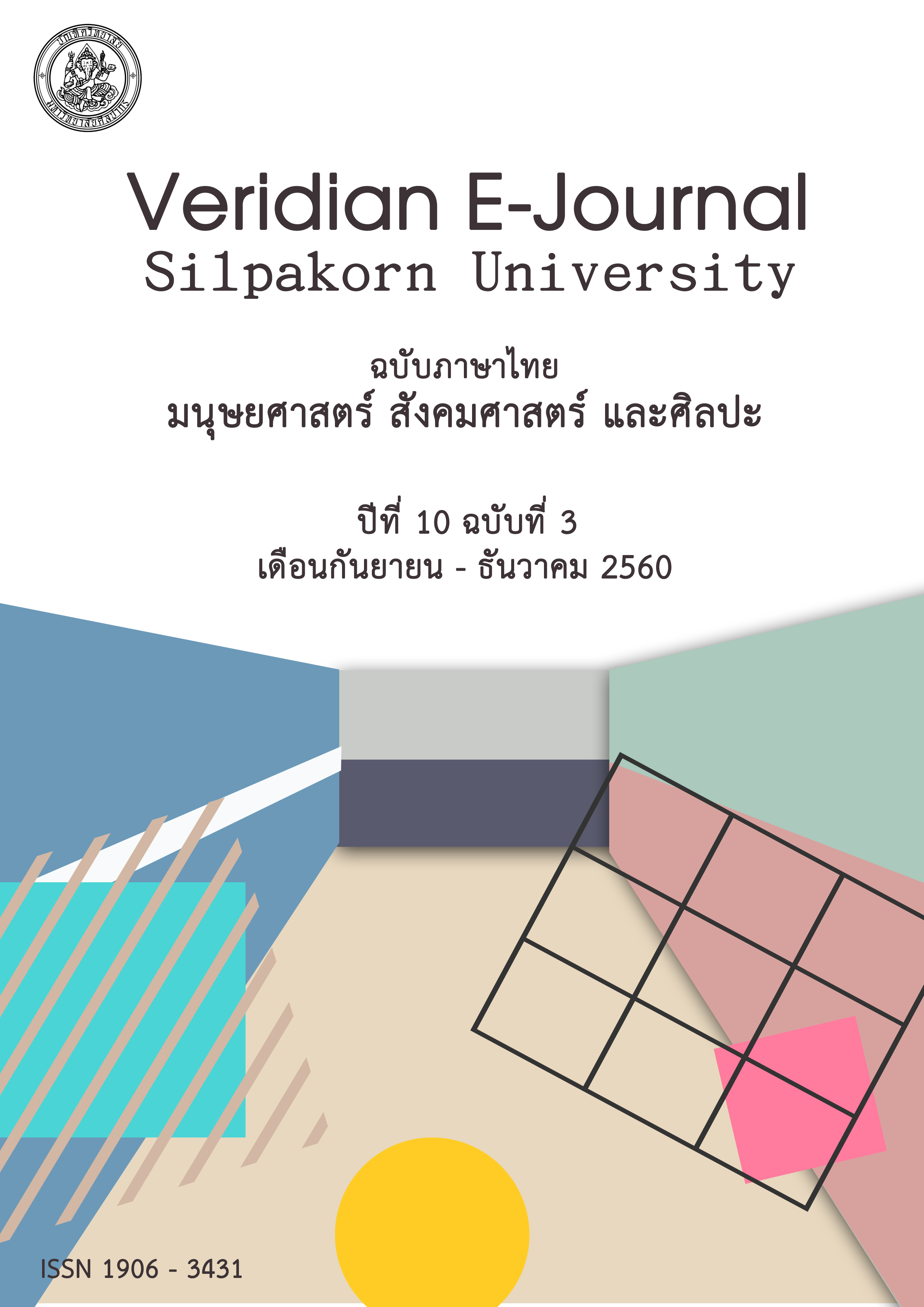ผลของการพัฒนาสมรรถนะการออกแบบการเรียนการสอนเพื่อการผลิตสื่อโดยใช้รูปแบบการสอนแบบชุมชนเป็นฐานการเรียนรู้ร่วมกับกระบวนการคิดเชิงออกแบบในนิสิตระดับ ปริญญาตรี สาขาเทคโนโลยีและสื่อสารการศึกษา มหาวิทยาลัยมหาสารคาม
Main Article Content
Abstract
การวิจัยครั้งนี้มีวัตถุประสงค์เพื่อ 1) ศึกษาพัฒนาการสมรรถนะการออกแบบการเรียนการสอน
เพื่อการผลิตสื่อก่อนและหลังเรียนของนิสิตที่เรียนด้วยรูปแบบการสอนแบบชุมชุนเป็นฐานการเรียนรู้ร่วมกับกระบวนการคิดเชิงออกแบบ และ 2) เปรียบเทียบสมรรถนะการออกแบบการเรียนการสอนเพื่อการผลิตสื่อ
ของนิสิตหลังเรียนด้วยรูปแบบการสอนแบบชุมชุนเป็นฐานการเรียนรู้ร่วมกับกระบวนการคิดเชิงออกแบบระหว่างคะแนนสมรรถนะที่นิสิตประเมินตนเอง อาจารย์ประเมินนิสิตและตัวแทนชุมชนประเมินนิสิต
กลุ่มตัวอย่างในการวิจัยครั้งนี้ ได้แก่ 1) นิสิตสาขาเทคโนโลยีและสื่อสารการศึกษา ชั้นปีที่ 2
คณะศึกษาศาสตร์ มหาวิทยาลัยมหาสารคามที่ลงทะเบียนเรียนในรายวิชา 0503 213 การออกแบบระบบ
การเรียนการสอนเพื่อการผลิตสื่อการศึกษา จำนวน 15 คน 2) อาจารย์ จำนวน 3 คน 3) ตัวแทนชุมชน ได้แก่ พยาบาลและนักวิชาการสาธารณสุข จำนวน 17 คน เครื่องมือที่ใช้ในการวิจัยประกอบด้วย 1) แบบประเมินสมรรถนะนิสิตสำหรับนิสิตประเมินตนเอง 2) แบบประเมินสมรรถนะนิสิตสำหรับอาจารย์ และ 3) แบบประเมินสมรรถนะนิสิตสำหรับตัวแทนชุมชน สถิติที่ใช้ในการวิจัย ได้แก่ ค่าเฉลี่ย ( ) ส่วนเบี่ยงเบนมาตรฐาน (S.D.)
การวิเคราะห์ความแปรปรวนทางเดียว (One-way ANOVA) และ การเปรียบเทียบพหุคูณ (Multiple comparison test) ด้วยวิธีของเชฟเฟ่ (Scheffe’s method)
ผลการวิจัย พบว่า
1. นิสิตที่เรียนด้วยรูปแบบการสอนแบบชุมชุนเป็นฐานการเรียนรู้ร่วมกับกระบวนการคิดเชิงออกแบบมีพัฒนาการของสมรรถนะการออกแบบการเรียนการสอนเพื่อการผลิตสื่อจากการประเมินตนเองสูงขึ้นในทุกด้านโดยสมรรถนะที่มีพัฒนาการเพิ่มขึ้น 3 อันดับแรก ได้แก่ สมรรถนะด้านวิเคราะห์ ( ก่อนเรียน = 2.30,หลังเรียน = 3.77, พัฒนาการ = 1.47 ) สมรรถนะด้านการสื่อสาร ( ก่อนเรียน = 2.42, หลังเรียน = 3.70, พัฒนาการ = 1.28) และ สมรรถนะด้านการพัฒนา ( ก่อนเรียน = 2.65, หลังเรียน = 3.83, พัฒนาการ = 1.18)
2. ค่าเฉลี่ยคะแนนสมรรถนะการออกแบบการเรียนการสอนเพื่อการผลิตสื่อหลังเรียนของนิสิตที่ประเมินโดยนิสิต อาจารย์และตัวแทนชุมชน มีความแตกต่างกันอย่างมีนัยสำคัญทางสถิติที่ระดับ .05 เมื่อทดสอบภายหลังด้วยวิธีของเชฟเฟ่ พบว่า มีความแตกต่างกัน 1 คู่ คือ ค่าเฉลี่ยคะแนนสมรรถนะหลังเรียนของนิสิตที่ประเมินโดยตัวแทนชุมชนสูงกว่าที่นิสิตประเมินตนเอง
The objectives of this study were to 1) study students’ competencies development of instructional design for media production before and after learning by instructional model of Community Based Learning with Design Thinking Process and 2) compare students’ post-learning competencies of instructional design for media production by comparing competencies assessment scores from student self-assessment, instructors and community representatives.
The sample of this study included 1) 15 sophomores from Educational Technology And Communications Major, Mahasarakham University who enrolled in the course 0503 213 Instructional System Design for Media Production, 2) 3 instructors and 3) 17 nurses and public health technical officers who were community representatives. Research instruments consisted of 1) Competencies assessment for student self-assessment, 2) Student Competencies assessment for instructors and 3) Student Competencies assessment for community representatives. Average ( ), Standard deviation (S.D), one – way ANOVA and Scheffe’s method of Multiple comparison test were used in this study as statistical data analysis tools.
Result of the study revealed that
.1 From self-assessment, students who learned by instructional model of Community Based Learning with Design Thinking Process had competencies development of instructional design for media production in all aspects. Top 3 of the most developed competencies were Analysis competency ( of pre-learning = 2.30, of post-learning = 3.77, of development = 1.47), Communication competency ( of pre-learning = 2.42, of post-learning = 3.70, of development = 1.28) and Development competency ( of pre-learning = 2.65, of post-learning = 3.83, of development = 1.18).
2. There were statistically significant differences at level .05 between average scores of post- learning competencies of instructional design for media production assessed by student self-assessment, instructors and community representatives. After testing by Scheffe’s method, it was found that there were one pair of difference. Average score of students’ post- learning competencies assessed by community representatives was higher than student self-assessment.

